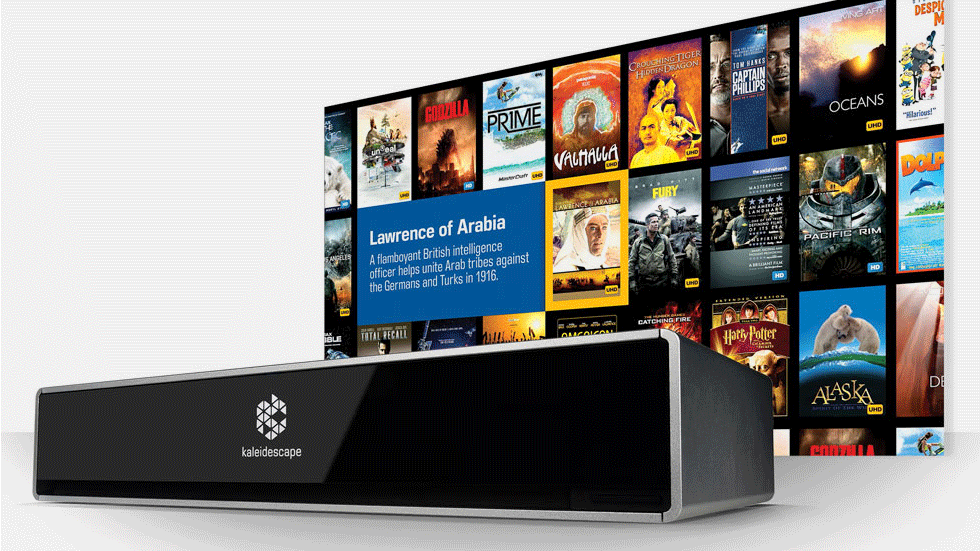
Building a long-planned, commercial-level quality Dolby Cinema in the home of Dolby execs.
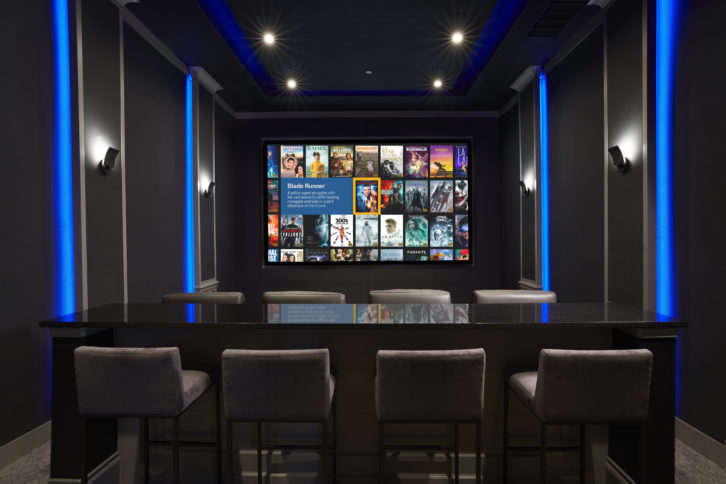
This home theater treats up to 12 guests with accurate sound provided by CAT- California Audio Technology and sourced by Kaleidescape. Photo by Kevin Marple.
As he moved into a brand-new Dallas-area home with his family, Doug Darrow saw his chance to build the home theater he had always wanted. As SVP, Cinema Business Group for Dolby, he had set some pretty high expectations. Fortunately, spouse buy-in wasn’t hard to acquire, as his wide Priscilla Morgan, is also a tech executive who once was part of the leadership team at Dolby and who recently joined the Kaleidescape Board of Directors [See sidebar].
Though the family has owned its share of home theaters in past homes, the theaters typically came with the house and the tech-savvy family worked with what already existed. Fortunately, a few years ago, for the first time, Darrow, Morgan, and their children moved into a new home that had a theater-area carved out on the first floor next to the family room, but it was completely empty.
“I’ve been working in this space for a very long time,” says Darrow, “and I’ve always had this goal of making an amazing home theater. I’ve been supplying equipment to- and working with installers of- home theater systems for decades. So when we moved into a home that had a really nice, well-designed space, I set out to do the home theater I’ve always wanted to do.
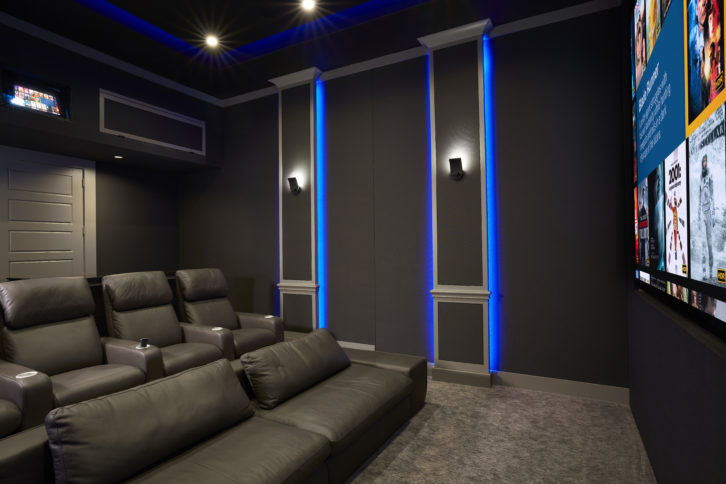
Each four-seat row has its own left and right side-channel loudspeaker (three each per side) Photo by Kevin Marple.
Getting Started
Darrow’s dream theater would have to match or surpass the Dolby Cinema experiences he has had a hand in creating over the past decade. Visually, that meant getting a christie CP 2315, which is a 175-pound, RGB, laser-driven projector that is more typically found in medium-to-large commercial movie theaters. As one of the source materials, he installed some of the equipment that he sells at Dolby to be able to play back DCI-quality movies, Which are the same ones sent to commercial theaters.
Darrow brought in Greg Margolis of HomeTronics to help design and install his dream home theater system, which involved putting the aforementioned commercial equipment into a space, 16 feet wide by 21 feet long, that was considerably smaller than it was design for. “We thought we’d build a room in the attic about it and use fold mirrors to get it down to the theater and out onto the screen, but then the second mirror was 3 feet wide, and that ends up being an alignment nightmare,” says Darrow. “Keeping that system stable over time was going to be ridiculous, so we scrapped that idea and decided to build a box in the back of the room to house the projector, which still required a fold mirror because now I had to fire it sideways relative to the screen.”
“We worked with Dolby for the overall room design, adds Margolis. “We took a commercial exhibition system and fitted it for residential use, so it’s got a full-blown Dolby CP850 processor, Christie LED RGB laser projector, and all the speaker locations on a small scale, but it’s the same type of loudspeaker positioning that you’d find in a commercial Dolby Atmos cinema and was submitted to Dolby for approval.”
“The projector emits way to much light for the 12-foot screen,” says Darrow. “This projector would light up a 40-foot wide screen easily. I use a high-contrast lens that the Christie team got for me, so it throws away light t get a higher dynamic range.”
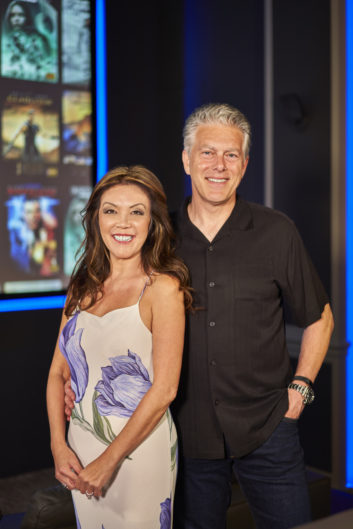
The home theater’s owners: Priscilla Morgan (left), who recently joined the Kaleidescape Board, and Doug Darrow, SVP, Cinema Business Group for Dolby. Photo by Kevin Marple.
For the speakers and audio processing, Darrow decided on CAT – California Audio Technology, founded in 1990 by Brian and Michael Barr, after an extensive auditioning process that included visiting two San Francisco- area and two Los Angeles-area CAT installations with fellow Dolby pros to get their perspective. “Brian has got just unbelievable installations in places that house some of the most incredible sound systems you can imagine,” says Darrow, “and I was blown away. They’re just really good, and the way they amplify and drive their speakers is as clean and pure as it gets.”
Darrow and his friends-turned-advisors needed to hear four systems because, although CAT always creates high-quality sound systems, they are all different because the company makes bespoke ultra-high-performance audio systems from scratch for each project. Yes, from scratch. “Everything at CAT is custom-built- all the way down to the loudspeaker enclosure, the driver motor, the driver cone, and even the bolts that secure out hardware,” says Brian Barr.
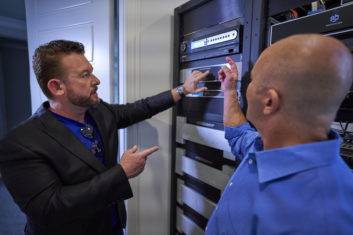
Brian Barr of CAT (left) and Greg Margolis of HomeTronics. Photo by Kevin Marple.
As far as the process, Barr continues “HomeTronics performed the project management for the team, making certain to involve CAT engineers at every stage of this process. HomeTronics worked on the drawings to be approved by the architect, the builder, the designer, and then CAT’s engineering and acoustic engineering teams, as well as our electronics team. This process goes back and forth several times before we can identify exactly what we’re building.
“Then we custom-manufactured all the custom CAT loudspeaker enclosures, crossovers, and drivers. We custom-built everything- every custom CAT loudspeaker received custom drivers all the way down to the nuts and bolts. In addition to the custom loudspeakers, we designed, engineered, and manufactured all the CAT amplification and all the CAT DSPs, as well. Every CAT amplifier and CAT DSP is built in Los Angeles. Then HomeTronics installed everything, and one of our CAT engineering teams flew in to custom on-site engineer, calibrate, and tune every single CAT loudspeaker in the room with out CAT DSPs.”
Speakers and (Lots of) Subs
CAT had plenty of speakers to custom manufacture for the space-32 in total. Across the front of the room are the left, center, right channels, with a subwoofer beneath, and mated, to each, respectively. There are two rows of theater seating and a back row of bar seating. Each four-seat row has its own left and right side-channel loudspeaker (three each per side) and two rear channels. Six speakers are used for the height channels, and the rest of the speakers are made up of 12 subwoofers strategically placed throughout the room for a balanced sound. CAT calls this subwoofer bass balancing process its “SBMS- Subwoofer Bass Management System.”
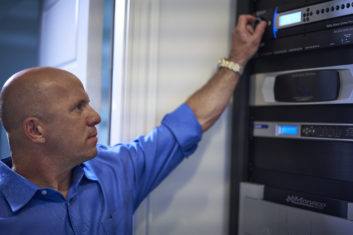
Greg Margolis of HomeTronics. Photo by Kevin Marple.
“We custom-built a dozen subwoofers that were strategically placed acoustically in the room at various locations, then, one of our traveling CAT engineering teams visited on-side and tuned all the LFE subwoofers with several CAT DSPs,” says Barr. “Essentially, the front subs deliver the sonic LFE audio information as it hits very fast and quick, then the other subwoofers react accordingly to balance out the bass at all 12 seating locations- so that you’re knocking the excess bass levels down in some locations where they would have been hot and adding some bass pressure in other locations where it would have been a little bit low. By eliminating the unwanted ‘boomy bass’ that most theaters suffer from, CAT SBMS allows the listeners to experience less hearing fatigue and increased realism in all frequencies- including more intelligible dialog- as they hear and feel an extremely accurate, fast, tight bass response ±1 dB across all 12 seating positions.”
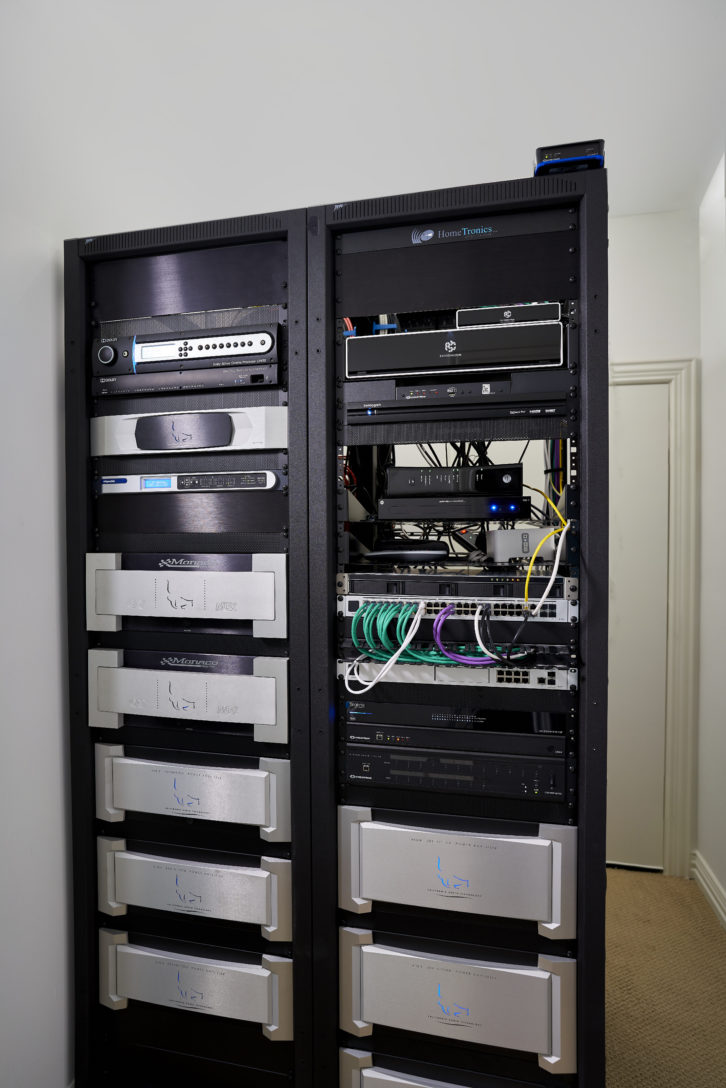
The theater’s rack holds the Dolby video processors, the Kaleidescape system, and plenty of audio processing from CAT. Photo by Kevin Marple.
Like the addition of the projector, the custom CAT sound system also required alterations to the room. “We ended up having to tear all the sheetrock and trim off of the existing wall,” sys Darrow. “We had to bring the screen wall out about 8 inches to fit the massive front 18-inch CAT subwoofers, and we had to lower the ceiling about 12 inches to have the floating effect and to put the height-channel speakers into it. We also ended up having to build an equipment room in the attic that had to be cooled.”
“People don’t realize that this small space requires very close to the same number of speakers used in a big space to do it properly,” says Barr. “I see it like designing a Formula 1 car- it’s like sitting 15 people in one car and custom building it around them to make it perform as best as it possibly can.”
With the focus on the AV technology in the room, at one point Darrow realized he needed to make the space aesthetically enticing, so he and Margolis decided to add lighting around the room. “We backlit all the columns and soffits, and the gap around the back of the screen with tunable RGB lighting,” says Margolis. “You can change the colours, and we actually have the code for getting ‘Dolby Blue’.”
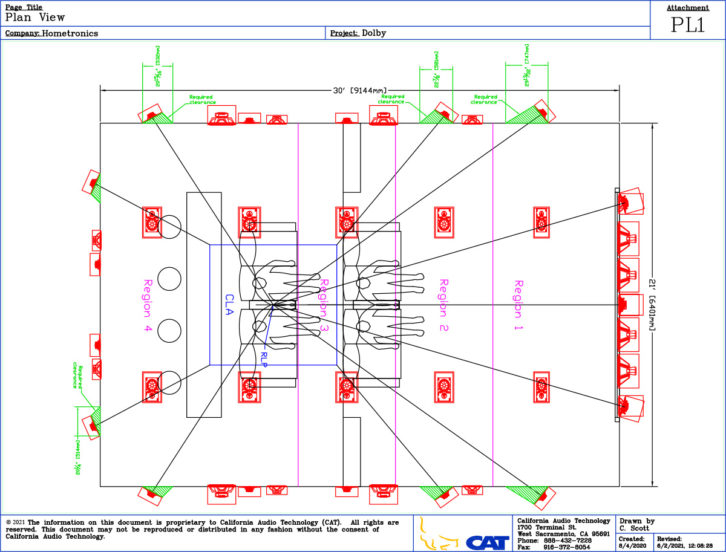
CAT’s room design
Consuming Content
While the room is served by a number of sources, including Darrow’s desired DCI files, the main source for movies is provided by Kaleidescape. Having this system in place serves two purposes for Darrow. Primarily, it is “a place to consume content,” but it also helps him in his day job. “I think it really helps me understand what’s going on in this space,” he says. “The DCI thing is its own unique animal, and most people would never mess around with it. Having a Kaleidescape solution allows me to have the top experience that a consumer could actually get in a home system, and I get to see how that works and how it plays in that environment.
“I understand better about what it is to put this kind of equipment into this environment versus putting it into a commercial theater, which we do all day long and it works great, but all of a sudden, when you have consumer sources hooked up and I’m going from a Kaleidescape box to a DCI source, to an Apple TV to whatever, sometimes that’s a little bumpy, and we’ve got to make that work a little better.”
As for Morgan, despite the job taking about a year and half longer than expected, she is thrilled with the results. “I complained all the way through it- ‘It’s too expensive,’ ‘You’re over budget’- but it is the most beautiful theater I’ve ever seen in my life,” she says. “I’d rather spend money building this out and have all the kids come home. And it’s not just them- my neighbors come over and we enjoy movie nights. They say, ‘You have a great home cinema, you have Kaleidescape, and you have all the movies that we want to watch. Why should we go out?'”
Darrow also has no regrets. “I didn’t cut any corners and I spared no expense,” he says. “This is the result of 25 years of thinking about a home theater that was going to be the one that I’ve always wanted to do.”
From Client to Board
Priscilla Morgan has a career made up of leadership positions in electronics companies. Currently, she is chief revenue officer at Alliance Consumer Group, a designer, manufacturer, and distributor of high-quality branded consumer products. Prior to that, she held executive-level positions at Oracle and Dolby, with expertise in finance, sales, field operations, and customer experience. She has now brought her skills and knowledge to Kaleidescape, recently joining the company’s Board of Directors.
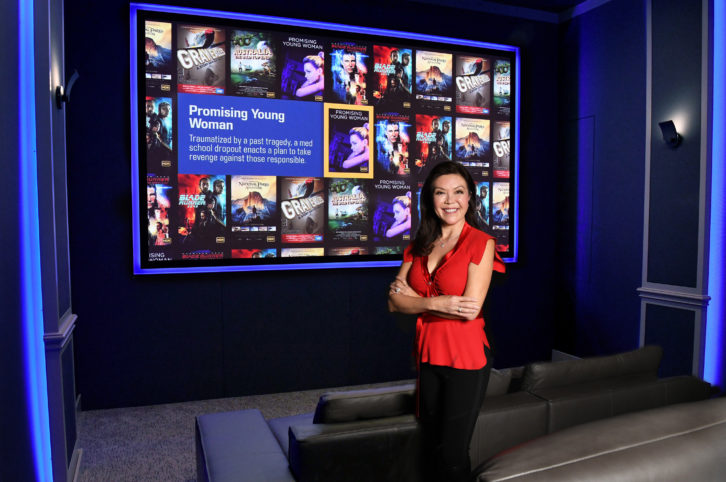
“When Tayloe [Stansbury, CEO, Kaleidescape] asked me to join, it was an absolute no-brainer,” says Morgan. “A big portion of why I joined the Board is because there is so much people don’t know about Kaleidescape- they know the Kaleidescape of 10 years ago; they don’t know it now.
“Tayloe really impressed me, and we got along right away. He’s absolutely customer first, and when I joined the Board he asked me to take a look at how we go to market, how we reinvent ourselves as a customer-first type company, and how we make sure that we marry that with the best technology we have to offer.”
In order to get there, Morgan sees a role for everything, including integrators. “It’s really looking at the end-to-end,” she says. “Everything has a very important part to play, but how do we get the education out there? How do we make sure clients get the beast playback experience in their theaters? The dealers are going to be crucial; that is part of their conversation.”
Toward that end, Kaleidescape recently began a training and certification program for dealers to make sure they understand the product and are installing it to its fullest potential- a potential Morgan is passionate about.
“What I love about the Kaleidescape experience is that the quality is bar none,” she says. “I believe in the product, I believe in the company, and I want more people to enjoy what I experience in my own home theater. “
